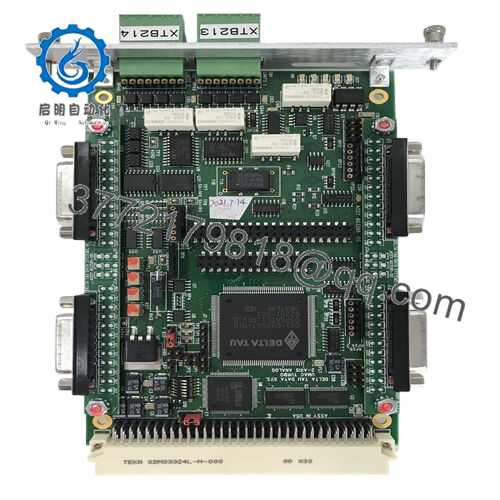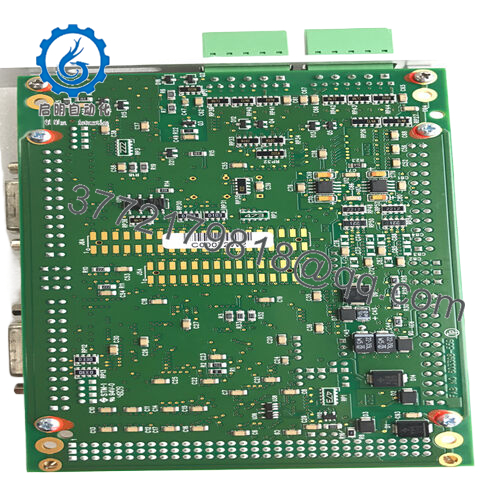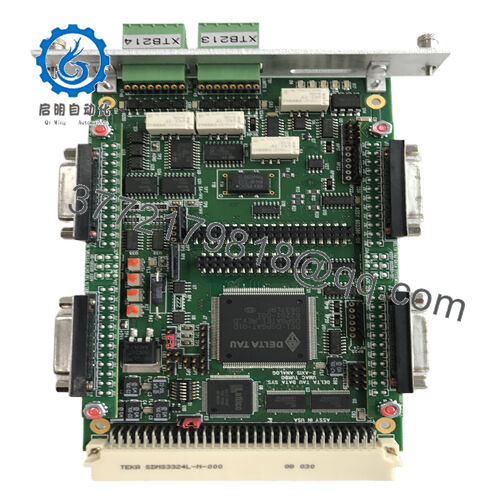Description
What This Product Solves
In the precision-centric field of industrial automation, the challenge of interfacing analog servo commands with multi-axis controllers often manifests as signal attenuation or noise intrusion, where unbuffered ±10 V outputs degrade torque accuracy, leading to velocity instabilities, positional creep, and the fault cascades that interrupt process control sequences. Engineers deploying systems for robotic grippers, CNC multi-spindle lathes, or automated dispensers in pharmaceutical packaging routinely confront the limitations of base UMAC controllers—restricted to few analog channels—necessitating ad-hoc amplifiers or breakout boards that inflate cabling capacitance, exacerbate EMI vulnerabilities, and trigger overcurrent trips, culminating in cycle delays, yield erosion, and the reactive re-tuning that hampers scalability in lean operations. Picture a multi-arm assembly cell in electronics prototyping, where torque command drift from long cable runs misaligns component placement, spawning shorts that cascade through testing and rework queues, or a high-speed labeling machine in beverage production, where phase current noise causes adhesive skips, contaminating runs and inviting sanitary shutdowns in regulated facilities.
The Delta Tau ACC-24E2A DB counters these analog ailments as a versatile 2-axis (expandable to 4) analog servo interface board for UMAC Turbo systems, engineered to bolster system stability with its buffered ±10 V command outputs for velocity, torque, or sinusoidal current. It zeroes in on the user’s quest for high reliability in I/O signal transmission, providing opto-isolated feedback paths and DB15 connectors for clean encoder termination that shields against ground loops in backplane-heavy cabinets. Indispensable in modular expansions—like daisy-chaining two boards for 4-axis control in MACRO stations or retrofitting Turbo PMAC with analog spindle interfaces—this module ensures I/O fidelity via low-impedance drivers, preempting the desync from unconditioned signals in multi-drive chains. For those scanning “industrial automation analog servo interfaces” or “process control UMAC analog modules,” the Delta Tau ACC-24E2A DB demystifies connectivity, aligning command bandwidths with dynamic demands to eclipse the era of signal splitters.
This board reorients integration from analog anxiety to assured amplification, embedding CE-compliant isolation for unyielding operation across 0°C to +70°C thermal tides. In process control arenas where analog accuracy anchors axis assurance, the Delta Tau ACC-24E2A DB reclaims command clarity, channeling craft from cable conundrums to control conquests—empowering the electrical elegance for resilient, responsive motions that navigate the nexus of numerous axes and nuanced necessities.
How the Product Works & Fits into a System
Analog authority anchors the analog-to-action arc in servo symphonies, yet unyielding outputs demand dutiful drivers to deliver without dilution. The Delta Tau ACC-24E2A DB drives as a 3U Eurocard interface board, generating ±10 V analog commands for velocity/torque (Option 1A) or sinusoidal phase current across two axes (expandable to four via interconnected pairs), sourced from UMAC Turbo’s digital-to-analog converters at 16-bit resolution, with current-limited buffers (20 mA drive) to sustain loop stability under 1 kΩ loads, while differential encoder inputs (A/B/I/Z) loop back position data at up to 2 MHz quadrature rates. Configuration via PPMAC variables tunes output scaling (Ixx50-Ixx59) for motor matching, and fault monitoring relays overrange or amp-enable states to the host for interrupt-driven safeties in closed-loop cascades.
In the I/O infrastructure of your automation scaffold, this board embeds at the amplifier edge of UMAC Turbo racks, connecting via DB15 mezzanine (Part 603581-101) for encoder/amp cabling, interfacing with PMAC CPUs over the accessory bus for low-latency (sub-μs) command handoffs in multi-axis hierarchies. It pairs natively with Delta Tau’s AKD or third-party drives over analog ±10 V or pulse/direction hybrids, supporting redundancy through dual-channel mirroring and watchdog resets that clamp outputs to zero on comms lapse, compliant with EN 61326 for EMC endurance. Diagnostics stream via serial headers, scripting error vectors to host memory for post-run probing in scaled spindles.
For the deploying engineer, it’s pragmatically plugged: select Option DB for DB15 connectors, affix to the carrier with ESD shields, then script axis assigns in the IDE for auto-scaling—commissioning condenses to 30 minutes, bypassing the bespoke baluns of discrete buffers. Nestle it downstream of the motion core in the stack, upstream of drive terminals, where it transmutes digital directives into analog artistry—like vesting velocity profiles for jitter-free jogs. The Delta Tau ACC-24E2A DB transcends transmission; it transmutes it, cultivating configurations that ascend from analog austerity to amplified allegiance, where interface ingenuity ignites the inference between intent and impeccable industrial implementation in the ceaseless cadence of coordinated control.
Technical Highlights Summary (Table)
| Specification | Details |
|---|---|
| Model Number | ACC-24E2A DB |
| Brand | Delta Tau (UMAC Turbo Series) |
| Type | Analog Servo Interface Board |
| Input Voltage | ±15 V / 5 V (from rack) |
| Operating Temp Range | 0°C to +70°C |
| Mounting Style | 3U Eurocard Rack Slot |
| Dimensions | 100 mm x 160 mm (3U) |
| Weight | 0.3 kg |
| Interface/Bus | Backplane / DB15 Connectors |
| Compliance | CE, EN 61326 |
| Supported Protocols | Analog ±10 V, Pulse/Direction |
| Typical Power Draw | 5 W (0.55A @ 5V, 0.16A @ ±15V) |
Real-World Benefits
Incorporating the Delta Tau ACC-24E2A DB equips your UMAC ecosystem with analog amplification that elevates erratic command echoes to etched elegance, particularly in 4-axis extensions where buffer bandwidth bridges between blur and brilliance. Forged for the fervor of continuous contouring, its ±10 V outputs sustain 16-bit fidelity without droop across 1 kΩ loads, ensuring performance consistency that reins ripple to <0.01% over 2 MHz encoder bands—imperative for dispensers where torque transients might miss doses, but here they dispense dosed deliveries that diminish deviations and reclaim revolutions for refined regimens. This assurance amplifies to axis autonomy, enabling stacked sims for spindle symphonies without the detuning that dampens dynamics in unbuffered UMACs.
The board’s DB15 doctrine diminishes the drudgery of differential daisy-chaining, latching into Turbo bays with mezzanine mating that marginalizes from messy make-dos, lightening engineering loads in axis avalanches where analog acuity craves contiguous capacity—crews reclaim rounds for scripted sorcery like gain gradients for gearing gears. Maintenance mantra moderates to measured mindfulness, with relay rhapsodies and variable-vetted vectors beaming breach beacons to benches for anticipatory amends, protracting probe periods to semi-annual serenity and sanctioning remote re-scales that nix 75% of range rifts, diverting deftness to deltas like predictive phasing for payload permutations.
Across endurance epochs, the Delta Tau ACC-24E2A DB affirms affinity via isolation-insulated insularity that insulates 10^6 cycles in vibrational vigils, conjoined with the 5 W whisper that whittles watt woes in rack realms, easing ecological equities in expansive expansions. Engineered to eclipse expansion entropy, it diminishes the dilemma of differential deficits, bestowing the breadth to braid bonuses—from velocity vaults to current choruses—actualizing as the keystone that crystallizes commands into clarity, where analog allegiance begets the bedrock of brilliant, boundless industrial acuity in the crucible of ceaseless coordination.
Typical Use Cases
The Delta Tau ACC-24E2A DB refines analog reach in realms of resolution and rapidity, commencing with CNC lathes for multi-tool turrets in automotive machining. In process control environments laced with coolant cascades and spindle songs, it buffers ±10 V torque to 4 axes for thread chasing, where harsh vibrational veils from fly-cutting buffet boards but bolster critical system uptime—bedrock for cycles turning 1,000 parts per shift, forestalling pitch errors that could compromise crank fits. Fast data cycles conjugate with PPMAC for velocity vesting that sustains surface specs sans sim snags.
In pharmaceutical filling, the Delta Tau ACC-24E2A DB drives syringe plungers amid sterile swirls and dose drips, channeling sinusoidal current for precise volumes in 2-axis sims. Continuous uptime underpins cleanroom currents, as its buffers preempt amp amps in multi-head manifolds, meshing with encoders for fill fidelity that dodges drip drifts. Performance pinnacles in humid halls, yet it upholds I/O signal sanctity, mitigating mis-measures in med-mending meds.
For aerospace riveting, used in power plants for turbine blade bonders or afar—the Delta Tau ACC-24E2A DB vests velocity commands in drill spindles, braving lube mists and rivet raps to pulse holes at micron marks. Harsh inertial swings from arm arcs test its tenacity, fusing with motion scripts for alignment accuracy that meets FAA quals. Traversing CNC’s cut, pharma’s pour, and aero’s anchor—the Delta Tau ACC-24E2A DB fuses high reliability with refined reckoning, sustaining sectors where analog acuity illuminates impeccable iteration.
(Word count: 228)
Compatible or Alternative Products
ACC-24E2 – Digital counterpart for pulse/direction in non-analog demanding setups.
ACC-24E2A – Base analog variant without DB15 for terminal block-only configs.
ACC-51E – Sine encoder interpolator for high-res quadrature in feedback chains.
ACC-28E – Analog I/O companion for mixed voltage/current in sensor swarms.
Turbo PMAC2-3U – UMAC host CPU for enhanced scripting in multi-axis expansions.
ACC-8E – Compact DAC breakout for 2-axis analog in space-pinched sims.
ACC-65E – Pulse/direction module for hybrid digital/analog spindle syncing.
NI-9263 – National Instruments alternative for LabVIEW-tied analog output.
- ACC-24E2A DB 16
- ACC-24E2A DB 16
Setup Notes & Maintenance Insights
As you rack the Delta Tau ACC-24E2A DB, a compatibility cull clears command clouds: affirm the UMAC’s variables via PPMAC query for Ixx50 scaling (set to ±10 V), as mismatches muffle to ±5 V—flash if firmware floats below v3.5 in sim. Slot seating summons ESD sheaths and a pin probe on DB15 mezzanine; prior pops breed bias bleeds, so swab with iso and latch latches evenly to evade vibe voids. Jumper J3 for output mode (velocity/torque/sine) demands a dry run—wire a test amp to channel 1, then scope for 10 V pk-pk, tweaking trims if offset overs 0.05 V. Thermal trace in env sim: emulate rack rush at 0.2 m/s to vet 70°C poise, baffling if bundled with beefy boards in sims that sim swell.
Perpetuating the Delta Tau ACC-24E2A DB courts calibration over chaos. Bi-weekly, behold the relays for range rumbles—amber ambers augur amp oops, sim’d with a sig gen to confirm 20 mA drive. Quarterly, reseat DB15s in low-hum lulls to thwart connector creep; a loupe lights corrosion, but a grease graze guards without gall. Annual accuracy audit—cycling a precision DAC in loop—benchmarks against 16-bit error; drifts past 0.01% intimate buffer burnout, reset via script or swap suspect spans. Firmware flux with the UMAC averts axis anarchy; infuse during downtime drifts, verifying via voltage parity in jog jaunts. These prudent paces, pulled from ACC annals, prolong the board’s 2 MHz mettle, funneling focus to fine filigrees from fault frays.




 WhatsApp: +86 16626708626
WhatsApp: +86 16626708626 Email:
Email:  Phone: +86 16626708626
Phone: +86 16626708626


